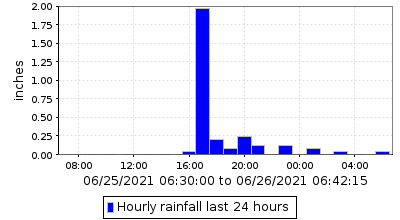Issue Date: Monday, June 28, 2021
Issue Time: 9:55 AM MDT
Summary:
Scattered thunderstorms began to form along the Front Range Mountains and Urban Corridor in the early afternoon yesterday, as well as the Northeast Plains. Storms generally moved northeastward and allowed for training cells, especially on the Northeast Plains. By late afternoon-early evening, storm coverage had also filled in in the Northern, Central, and San Juan Mountains. Rainfall rates with these storms were generally low however, resulting in low 24-hour accumulations. For rainfall estimates in your area, check out the State Precipitation Map below.
Even with lower total storm accumulations, after several days of consistent rainfall burn scars were particularly vulnerable to flood conditions. For the second time this weekend, a debris flow from rainfall on the Grizzly Peak burn scar closed I-70 in Glenwood Canyon. Rainfall over the burn area on Sunday was light, less than 0.25 inches, but still enough to produce a debris flow coverage area of 80 feet wide and 5 feet deep, as seen in the pictures tweeted from CDOT.
⚠UPDATE: I-70 Glenwood Canyon is closed overnight from Exit 87 to Exit 133. CDOT crews will continue clearing mudflow debris overnight and will reassess the debris & closure in the morning. All updates will post https://t.co/SO2TG3LpBX courtesy #GlenwoodSprings Fire Dept. https://t.co/aeyhy3S6SL pic.twitter.com/Yi3CKQTSW7
— Colorado Department of Transportation (CDOT) (@ColoradoDOT) June 28, 2021
There was also flooding on the Calwood burn scar in Jamestown yesterday. A flood advisory was issued in the evening, followed by a upgrade to flash flood warning after Doppler radar indicated heavy rain. Law enforcement in Jamestown reported a 3-4 foot surge of debris and water flowing down Geer Canyon.
Click Here For Map Overview







